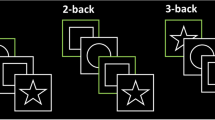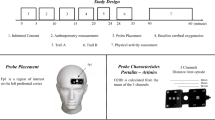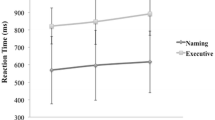Abstract
International physical activity guidelines recommend that older adults accumulate 150 min/week of moderate-vigorous physical activity (MVPA). It is unclear whether meeting this recommendation is associated with better higher-order cognitive functions and if so, what are the neurophysiological mechanisms responsible for such a relationship. We tested the hypothesis that meeting MVPA guidelines is associated with better executive function in older adults, and explored if greater increases in prefrontal cortex oxygenation are implicated. Older adults who did (active, n = 19; 251 ± 79 min/week) or who did not (inactive, n = 16; 89 ± 33 min/week) achieve activity guidelines were compared. Executive function was determined via a computerized Stroop task while changes in left prefrontal cortex oxygenation (ΔO2Hb) were measured with functional near-infrared spectroscopy. Aerobic fitness (\(\dot{VO}\) 2peak) was determined using a graded, maximal cycle ergometry test. MVPA and sedentary time were objectively assessed over 5 days. Both groups had similar (both, P > 0.11) levels of aerobic fitness (24.9 ± 8.9 vs. 20.9 ± 5.6 ml/kg/min) and sedentary time (529 ± 60 vs. 571 ± 90 min/day). The active group had faster reaction times (1193 ± 230 vs. 1377 ± 239 ms, P < 0.001) and greater increases in prefrontal cortex ΔO2Hb (9.4 ± 5.6 a.u vs. 5.8 ± 3.4 a.u, P = 0.04) during the most executively demanding Stroop condition than the Inactive group. Weekly MVPA was negatively correlated to executive function reaction times (r = − 0.37, P = 0.03) but positively correlated to the ΔO2Hb responses (r = 0.39. P = 0.02) during the executive task. In older adults, meeting MVPA guidelines is associated with better executive function and larger increases in cerebral oxygenation among older adults.


Similar content being viewed by others
References
Fjell AM, Sneve MH, Grydeland H, et al. The disconnected brain and executive function decline in aging. Cereb Cortex. 2017;27:2303–17. https://doi.org/10.1093/cercor/bhw082.
Clark LR, Schiehser DM, Weissberger GH, et al. Specific measures of executive function predict cognitive decline in older adults. J Int Neuropsychol Soc. 2012;18:118–27. https://doi.org/10.1017/S1355617711001524.
Levy G, Jacobs DM, Tang M-X, et al. Memory and executive function impairment predict dementia in Parkinson’s disease. Mov Disord. 2002;17:1221–6. https://doi.org/10.1002/mds.10280.
Shea TB, Remington R. Cognitive improvement in healthy older adults can parallel that of younger adults following lifestyle modification: support for cognitive reserve during aging. J Alzheimers Dis Rep. 2018;2:201–5. https://doi.org/10.3233/adr-180056.
Dupuy O, Gauthier CJ, Fraser SA, et al. Higher levels of cardiovascular fitness are associated with better executive function and prefrontal oxygenation in younger and older women. Front Hum Neurosci. 2015; 9.https://doi.org/10.3389/fnhum.2015.00066.
Mekari S, Dupuy O, Martins R, et al. The effects of cardiorespiratory fitness on executive function and prefrontal oxygenation in older adults. GeroScience. 2019;41:681–90. https://doi.org/10.1007/s11357-019-00128-5.
Freudenberger P, Petrovic K, Sen A, et al. Fitness and cognition in the elderly. Neurology. 2016;86:418–24. https://doi.org/10.1212/WNL.0000000000002329.
Reuter-Lorenz PA, Festini SB, Jantz TK. Executive functions and neurocognitive aging. In: Handbook of the Psychology of Aging. 8th ed. Elsevier; 2015, pp 245–262.
Colcombe SJ, Kramer AF, Erickson KI, et al. Cardiovascular fitness, cortical plasticity, and aging. Proc Natl Acad Sci. 2004;101:3316–21. https://doi.org/10.1073/pnas.0400266101.
Tremblay MS, Warburton DE, Janssen I, et al. New Canadian physical activity guidelines. Appl Physiol Nutr Metab. 2011;36:36–46. https://doi.org/10.1139/H11-009.
Physical Activity Guidelines Advisory Committee. 2018 Physical activity guidelines advisory committee scientific report. Washington: US Department of Health and Human; 2018.
Statistics-Canada. Directly measured physical activity of adults, 2012 and 2013. Health Fact Sheet. 2015.
Harvey JA, Chastin SFM, Skelton DA. How sedentary are older people? A systematic review of the amount of sedentary behavior. J Aging Phys Act. 2015;23:471–87.
Barnes DE, Blackwell T, Stone KL, et al. Cognition in older women: the importance of daytime movement. J Am Geriatr Soc. 2008;56:1658–64. https://doi.org/10.1111/j.1532-5415.2008.01841.x.
Kerr J, Marshall SJ, Patterson RE, et al. Objectively measured physical activity is related to cognitive function in older adults. J Am Geriatr Soc. 2013;61:1927–31. https://doi.org/10.1111/jgs.12524.
Thivel D, Tremblay A, Genin PM, et al. Physical activity, inactivity, and sedentary behaviors: definitions and implications in cccupational health. Front Public Heal. 2018; 6.https://doi.org/10.3389/fpubh.2018.00288.
Tremblay MS, Aubert S, Barnes JD, et al. Sedentary behavior research network (SBRN) – terminology consensus project process and outcome. Int J Behav Nutr Phys Act. 2017;14:75. https://doi.org/10.1186/s12966-017-0525-8.
Nokes N. Relationship between physical activity and aerobic fitness. J Sports Med Phys Fitness. 2009;49:136–41.
Costa AM, Breitenfeld L, Silva AJ, et al. Genetic inheritance effects on endurance and muscle strength. Sport Med. 2012;42:449–58. https://doi.org/10.2165/11650560-000000000-00000.
Zeiher J, Ombrellaro KJ, Perumal N, et al. Correlates and determinants of cardiorespiratory fitness in adults: a systematic review. Sport Med - Open. 2019;5:39. https://doi.org/10.1186/s40798-019-0211-2.
Faul F, Erdfelder E, Buchner A, Lang A-G. Statistical power analyses using G*Power 3.1: tests for correlation and regression analyses. Behav Res Methods. 2009;41:1149–60. https://doi.org/10.3758/BRM.41.4.1149.
Sattler MC, Jaunig J, Tösch C, et al. Current evidence of measurement properties of physical activity questionnaires for older adults: an updated systematic review. Sport Med. 2020;50:1271–315. https://doi.org/10.1007/s40279-020-01268-x.
O’Brien MW, Robinson SA, Frayne RJ, et al. Achieving Canadian physical activity guidelines is associated with better vascular function independent of aerobic fitness and sedentary time in older adults. Appl Physiol Nutr Metab. 2018;43:1003–9.
O’Brien MW, Johns JA, Dorey TW, et al. Meeting international aerobic physical activity guidelines is associated with enhanced cardiovagal baroreflex sensitivity in healthy older adults. Clin Auton Res. 2020;30:139–48. https://doi.org/10.1007/s10286-019-00641-9.
Mekari S, Neyedli HF, Fraser S, et al. High-intensity interval training improves cognitive flexibility in older adults. Brain Sci. 2020;10:1–12. https://doi.org/10.3390/brainsci10110796.
O’Brien MW, Johns JA, Robinson SA, et al. Impact of high-intensity interval training, moderate-intensity continuous training, and resistance training on endothelial function in older adults. Med Sci Sport Exerc. 2020;52:1057–67. https://doi.org/10.1249/MSS.0000000000002226.
Hart TL, Swartz AM, Cashin SE, Strath SJ. How many days of monitoring predict physical activity and sedentary behaviour in older adults? Int J Behav Nutr Phys Act. 2011;8:62. https://doi.org/10.1186/1479-5868-8-62.
Edwardson C, Winkler E, Bodicoat D, et al. Considerations when using the activPAL monitor in field-based research with adult populations. J Sport Heal Sci. 2017;6:162–78. https://doi.org/10.1016/j.jshs.2016.02.002.
O’Brien M, Wojcik WR, D’Entremont L, Fowles JR. Validation of the PiezoRx® step count and moderate to vigorous physical activity times in free living conditions in adults: a pilot study. Int J Exerc Sci. 2018;11:541–51.
O’Brien M, Wojcik W, Fowles J. Medical-grade physical activity monitoring for measuring step count and moderate-to-vigorous physical activity: validity and reliability study. JMIR mHealth uHealth. 2018;6:e10706. https://doi.org/10.2196/10706.
O’Brien M, Kivell MJ, Wojcik WR, et al. Influence of anthropometrics on step-rate thresholds for moderate and vigorous physical activity in older adults: scientific modeling study. JMIR Aging. 2018;1:e12363. https://doi.org/10.2196/12363.
O’Brien MW, Wojcik WR, Fowles JR. Validity and interinstrument reliability of a medical grade physical activity monitor in older adults. J Meas Phys Behav. 2021;4:31–8. https://doi.org/10.1123/jmpb.2019-0074.
Zakzanis KK, Mraz R, Graham SJ. An fMRI study of the Trail Making Test. Neuropsychologia. 2005;43:1878–86. https://doi.org/10.1016/j.neuropsychologia.2005.03.013.
Ekkekakis P. Illuminating the black box: Investigating prefrontal cortical hemodynamics during exercise with near-infrared spectroscopy. J Sport Exerc Psychol. 2009;31:505–53. https://doi.org/10.1123/jsep.31.4.505.
Bixby WR, Spalding TW, Haufler AJ, et al. The unique relation of physical activity to executive function in older men and women. Med Sci Sports Exerc. 2007;39:1408–16. https://doi.org/10.1249/mss.0b013e31806ad708.
Busse AL, Gil G, Santarém JM, Jacob Filho W. Physical activity and cognition in the elderly: a review. Dement Neuropsychol. 2009;3:204–8. https://doi.org/10.1590/S1980-57642009DN30300005.
Gajewski PD, Falkenstein M. Long-term habitual physical activity is associated with lower distractibility in a Stroop interference task in aging: Behavioral and ERP evidence. Brain Cogn. 2015;98:87–101. https://doi.org/10.1016/j.bandc.2015.06.004.
Salthouse TA. What cognitive abilities are involved in trail-making performance? Intelligence. 2011;39:222–32. https://doi.org/10.1016/j.intell.2011.03.001.
Guadagni V, Drogos LL, Tyndall AV, et al. Aerobic exercise improves cognition and cerebrovascular regulation in older adults. Neurology. 2020;94:e2245–57. https://doi.org/10.1212/WNL.0000000000009478.
Churchill JD, Galvez R, Colcombe S, et al. Exercise, experience and the aging brain. Neurobiol Aging. 2002;23:941–55. https://doi.org/10.1016/S0197-4580(02)00028-3.
Tsukamoto H, Suga T, Takenaka S, et al. Greater impact of acute high-intensity interval exercise on post-exercise executive function compared to moderate-intensity continuous exercise. Physiol Behav. 2016;155:224–30. https://doi.org/10.1016/j.physbeh.2015.12.021.
Murman DL. The impact of age on cognition. Semin Hear. 2015;36:111–21. https://doi.org/10.1055/s-0035-1555115.
Evans DA, Funkenstein HH, Albert MS, et al. Prevalence of Alzheimer’s disease in a community population of older persons: Higher than previously reported. JAMA J Am Med Assoc. 1989;262:2551–6. https://doi.org/10.1001/jama.1989.03430180093036.
McCarrey AC, An Y, Kitner-Triolo MH, et al. Sex differences in cognitive trajectories in clinically normal older adults. Psychol Aging. 2016;31:166–75. https://doi.org/10.1037/pag0000070.
Herold F, Wiegel P, Scholkmann F, Müller N. Applications of functional near-infrared spectroscopy (fNIRS) neuroimaging in exercise–cognition science: a systematic, methodology-focused review. J Clin Med. 2018;7:466. https://doi.org/10.3390/jcm7120466.
Mekari S, Fraser S, Bosquet L, et al. The relationship between exercise intensity, cerebral oxygenation and cognitive performance in young adults. Eur J Appl Physiol. 2015;115:2189–97. https://doi.org/10.1007/s00421-015-3199-4.
Bailey DM, Marley CJ, Brugniaux JV, et al. Elevated aerobic fitness sustained throughout the adult lifespan is associated with improved cerebral hemodynamics. Stroke. 2013;44:3235–8. https://doi.org/10.1161/STROKEAHA.113.002589.
Funding
Support for the work was provided by a Dalhousie University, Faculty of Health Research Development grant (to D.S. Kimmerly), a Nova Scotia Health Research Foundation (NSHRF) Development/Innovation grant (to D.S. Kimmerly and S. Mekary), as well as the Acadia University McCain Foundation Fund (to S. Mekary). M.W. O’Brien was supported by a Killam PreDoctoral Scholarship, Heart & Stroke Foundation of Canada BrightRed Scholarship, a Nova Scotia Graduate Scholarship, a Research Nova Scotia-Scotia Scholars Award, and Fredrick Banting and Charles Best CIHR Doctoral Award.
Author information
Authors and Affiliations
Corresponding author
Ethics declarations
Competing interests
The authors declare no competing interests.
Additional information
Publisher's note
Springer Nature remains neutral with regard to jurisdictional claims in published maps and institutional affiliations.
About this article
Cite this article
O’Brien, M.W., Kimmerly, D.S. & Mekari, S. Greater habitual moderate-to-vigorous physical activity is associated with better executive function and higher prefrontal oxygenation in older adults. GeroScience 43, 2707–2718 (2021). https://doi.org/10.1007/s11357-021-00391-5
Received:
Accepted:
Published:
Issue Date:
DOI: https://doi.org/10.1007/s11357-021-00391-5




